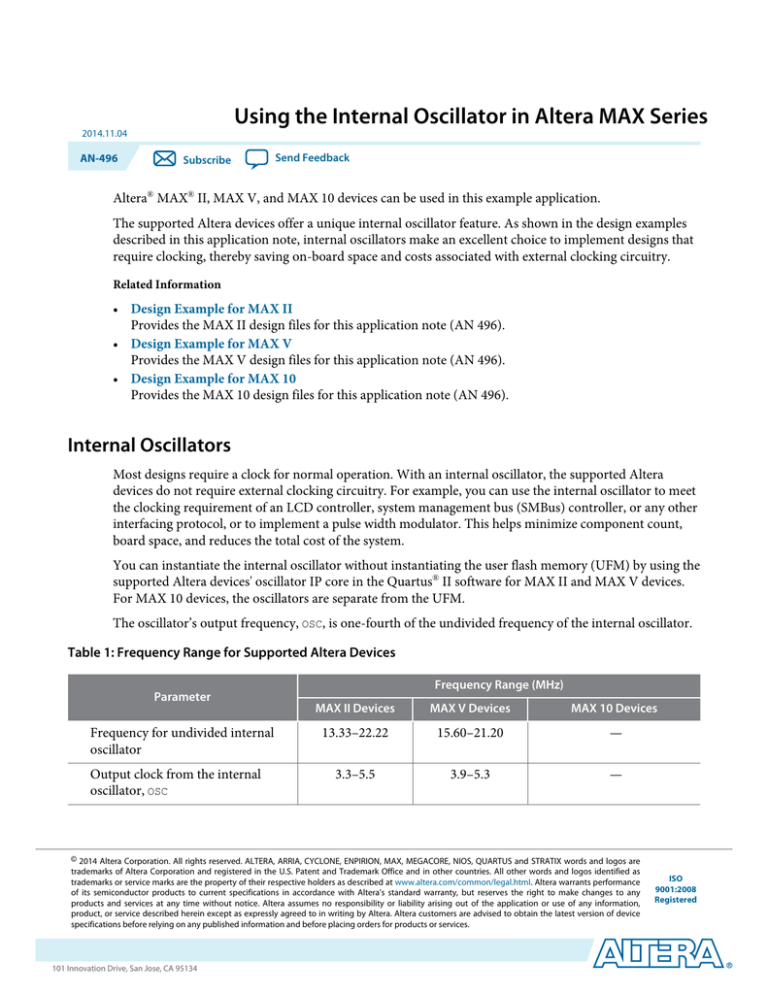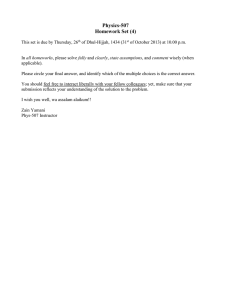
Using the Internal Oscillator in Altera MAX Series
2014.11.04
AN-496
Subscribe
Send Feedback
Altera® MAX® II, MAX V, and MAX 10 devices can be used in this example application.
The supported Altera devices offer a unique internal oscillator feature. As shown in the design examples
described in this application note, internal oscillators make an excellent choice to implement designs that
require clocking, thereby saving on-board space and costs associated with external clocking circuitry.
Related Information
• Design Example for MAX II
Provides the MAX II design files for this application note (AN 496).
• Design Example for MAX V
Provides the MAX V design files for this application note (AN 496).
• Design Example for MAX 10
Provides the MAX 10 design files for this application note (AN 496).
Internal Oscillators
Most designs require a clock for normal operation. With an internal oscillator, the supported Altera
devices do not require external clocking circuitry. For example, you can use the internal oscillator to meet
the clocking requirement of an LCD controller, system management bus (SMBus) controller, or any other
interfacing protocol, or to implement a pulse width modulator. This helps minimize component count,
board space, and reduces the total cost of the system.
You can instantiate the internal oscillator without instantiating the user flash memory (UFM) by using the
supported Altera devices' oscillator IP core in the Quartus® II software for MAX II and MAX V devices.
For MAX 10 devices, the oscillators are separate from the UFM.
The oscillator’s output frequency, OSC, is one-fourth of the undivided frequency of the internal oscillator.
Table 1: Frequency Range for Supported Altera Devices
Parameter
Frequency for undivided internal
oscillator
Output clock from the internal
oscillator, OSC
Frequency Range (MHz)
MAX II Devices
MAX V Devices
MAX 10 Devices
13.33–22.22
15.60–21.20
—
3.3–5.5
3.9–5.3
—
© 2014 Altera Corporation. All rights reserved. ALTERA, ARRIA, CYCLONE, ENPIRION, MAX, MEGACORE, NIOS, QUARTUS and STRATIX words and logos are
trademarks of Altera Corporation and registered in the U.S. Patent and Trademark Office and in other countries. All other words and logos identified as
trademarks or service marks are the property of their respective holders as described at www.altera.com/common/legal.html. Altera warrants performance
of its semiconductor products to current specifications in accordance with Altera's standard warranty, but reserves the right to make changes to any
products and services at any time without notice. Altera assumes no responsibility or liability arising out of the application or use of any information,
product, or service described herein except as expressly agreed to in writing by Altera. Altera customers are advised to obtain the latest version of device
specifications before relying on any published information and before placing orders for products or services.
www.altera.com
101 Innovation Drive, San Jose, CA 95134
ISO
9001:2008
Registered
2
AN-496
2014.11.04
Internal Oscillators
Frequency Range (MHz)
Parameter
MAX II Devices
MAX V Devices
—
—
Output clock from the internal
oscillator, clkout
MAX 10 Devices
55–116 (1)
35–77 (2)
Figure 1: Internal Oscillator as Part of the UFM for MAX II and MAX V Devices
UFM Block
PROGRAM
RPT_BUSY
Program Erase
Control
ERASE
OSC
OSC_ENA
BUSY
4
OSC
UFM Sector 1
ARCLK
Address
Register
ARSHFT
9
UFM Sector 0
16
16
ARDin
DRDin
Data Register
DRDout
DRCLK
DRSHFT
The internal oscillator is part of the Program Erase Control block, which controls the programming and
erasing of the UFM. The data register holds the data to be sent or retrieved from the UFM. The address
register holds the address from which data is retrieved or the address to which the data is written.
(1)
(2)
This frequency range applies for 10M02, 10M04, 10M08, 10M16, and 10M25 devices.
This frequency range applies for 10M40 and 10M50 devices.
Altera Corporation
Using the Internal Oscillator in Altera MAX Series
Send Feedback
AN-496
2014.11.04
Using the Internal Oscillator in MAX II and MAX V Devices
3
The internal oscillator for the UFM block is enabled when the ERASE, PROGRAM, and READ operation
is executed.
Table 2: Pin Description for the Oscillator IP Core in MAX II and MAX V Devices
Signal
OSC_ENA
Description
Use to enable the internal oscillator.
Output of the internal oscillator. This signal is low when the
oscillator is not enabled.
OSC
Using the Internal Oscillator in MAX II and MAX V Devices
The internal oscillator has a single input, OSC_ENA, and a single output, OSC. To activate the internal
oscillator, use OSC_ENA. When activated, a clock with the frequency is made available at the output. If
OSC_ENA is driven low, the output of the internal oscillator is a constant high.
To instantiate the internal oscillator, follow these steps:
1. On the Tools menu of the Quartus II software, click IP Catalog.
2. Under the Library category, expand the Basic Functions and I/O.
3. Select MAX II/MAX V oscillator and after clicking Add, the IP Parameter Editor appears. You can
now select the oscillator output frequency.
4. In Simulation Libraries, the model files that must be included are listed. Click Next.
5. Select the files to be created. Click Finish.
The selected files are created and can be accessed from the output file folder. After the instantiation code
is added to the file, the OSC_ENA input must be made as a wire and assigned as a logic value of “1” to
enable the oscillator.
Using the Internal Oscillator in MAX 10 Devices
The internal oscillator has a single input, OSC_ENA, and a single output, OSC. To activate the internal
oscillator, use OSC_ENA. When activated, a clock with the frequency is made available at the output. If
OSC_ENA is driven low, the output of the internal oscillator is a constant low.
To instantiate the internal oscillator, follow these steps:
1.
2.
3.
4.
On the Tools menu of the Quartus II software, click IP Catalog.
Under the Library category, expand the Basic Functions and Configuration Programming.
Select Internal Oscillator and after clicking Add, the IP Parameter Editor appears.
In the New IP Instance dialog box:
• Set the top-level name of your IP.
• Select the Device family.
• Select the Device.
5. Click OK.
6. To generate the HDL, click Generate HDL.
7. Click Generate.
Using the Internal Oscillator in Altera MAX Series
Send Feedback
Altera Corporation
4
AN-496
2014.11.04
Implementation
The selected files are created and can be accessed from the output file folder as specified in the output
directory path. After the instantiation code is added to the file, the OSC_ENA input must be made as a wire
and assigned as a logic value of “1” to enable the oscillator.
Implementation
You can implement these design examples with MAX II, MAX V, and MAX 10 devices, all of which have
the internal oscillator feature. Implementation involves demonstration of the internal oscillator function
by assigning the oscillator output to a counter and driving the general purpose I/O (GPIO) pins on MAX
II, MAX V, and MAX 10 devices.
Design Example 1: Targeting a MDN-82 Demo Board (MAX II Devices)
Design Example 1 is made to drive the LEDs to create a scrolling effect, thereby demonstrating the
internal oscillator using the MDN-82 demo board.
The following table lists the EPM240G pin assignments for Design Example 1.
Table 3: Pin Assignments for Design Example 1 Using the MDN-82 Demo Board
EPM240G Pin Assignments
Signal
Pin
Signal
Pin
d2
Pin 69
d3
Pin 40
d5
Pin 71
d6
Pin 75
d8
Pin 73
d10
Pin 73
d11
Pin 75
d12
Pin 71
d4_1
Pin 85
d4_2
Pin 69
d7_1
Pin 87
d7_2
Pin 88
d9_1
Pin 89
d9_2
Pin 90
sw9
Pin 82
—
—
Assign the unused pins As input tri-stated in the Quartus II software.
To demonstrate this design on the MDN-B2 demo board, follow these steps:
1. Turn on the power to the demo board (using slide switch SW1).
2. Download the design onto the MAX II CPLD through the JTAG header JP5 on the demo board and a
conventional programming cable (ByteBlaster™ II or USB-Blaster™). Keep SW4 on the demo board
pressed before and during the start of the programming process. After it completes, turn off the power
and remove the JTAG connector.
3. Observe the scrolling LED sequence on the red LEDs and the bi-color LEDs. Pressing SW9 on the
demo board disables the internal oscillator and the scrolling LEDs will freeze at their current positions.
Altera Corporation
Using the Internal Oscillator in Altera MAX Series
Send Feedback
AN-496
2014.11.04
Design Example 2: Targeting a MAX V Device Development Kit
5
Design Example 2: Targeting a MAX V Device Development Kit
In Design Example 2, the oscillator output frequency is divided by 221 before clocking a 2-bit counter. The
output of this 2-bit counter is used to drive the LEDs, thereby demonstrating the internal oscillator on the
MAX V device development kit.
The following table lists the 5M570Z pin assignments for Design Example 2.
Table 4: Pin Assignments for Design Example 2 Using the MAX V Device Development Kit
5M570Z Pin Assignments
Signal
Pin
Signal
Pin
pb0
M9
LED[0]
P4
osc
M4
LED[1]
R1
clk
P2
—
—
To demonstrate this design on the MAX V development kit, follow these steps:
1. Plug in the USB cable into the USB Connector to power up the device.
2. Download the design onto the MAX V device through the embedded USB-Blaster.
3. Observe the blinking LEDs (LED[0] and LED[1]). Pressing pb0 on the demo board disables the
internal oscillator and the blinking LEDs will freeze at their current state.
Document Revision History
Date
Version
Changes
November 2014
2014.11.04
Updated the frequency for undivided internal
oscillator and output clock from internal
oscillator frequency values for MAX 10
devices in the Frequency Range for Supported
Altera Devices table.
September 2014
2014.09.22
Added MAX 10 devices.
January 2011
2.0
Updated to include MAX V devices.
December 2007
1.0
Initial release.
Using the Internal Oscillator in Altera MAX Series
Send Feedback
Altera Corporation





